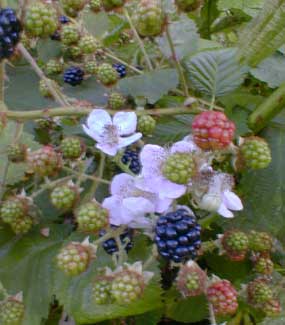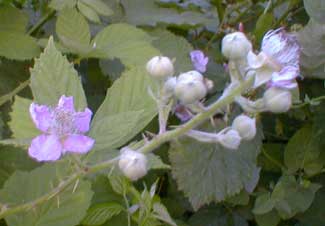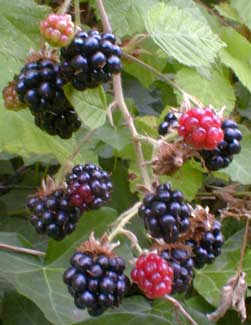
Himalayan Blackberry
"Nobody in the lane, & nothing, nothing but blackberries,
Blackberries on either side, though on the right mainly,
A blackberry alley, going down in hooks, & a sea
Somewhere at the end of it, heaving. Blackberries
Big as the ball of my thumb, & dumb as eyes
Ebon in the hedges, fat
With blue-red juices. These they squander on my fingers.
I had not asked for such a blood sisterhood; they must love me."
-Sylvia Plath
(1932-1963)
(1932-1963)
The Himalayan Blackberry Rubus armeniacus (often but mistakenly given as R. discolor, R. fruticosa & R. procerus) is an invasive large-fruiting gigantic briar that has become quite a pest throughout the Pacific Northwest from northern California to southern Alaska. As a child we called them English blackberries, but there is nothing English about them.
It was originally native to Armenia but had been introduced into Europe by 1835, first in Germany where it was imported for gardens. It found its way to New Zealand & North America by 1885. It has equally colonized South Africa, while a sub-race has spread in Australia. Of all the places it has established itself, none has so thoroughly pleased it as the Pacific Northwest where autumn through spring is wet & summers are surprisingly dry.
 On Puget Sound & in British Columbia, it is a semi-evergreen perennial that turns up in alleyways, along railroad tracks, takes over clear-cuts & roadsides, with limitless spread, finding its way even into old-growth forests where it displaces precious native substory plants. The briars are so substantial that twenty-foot ladders can be laid down over them to climb out over the tops of briar patches harvesting the less accessible fruits.
On Puget Sound & in British Columbia, it is a semi-evergreen perennial that turns up in alleyways, along railroad tracks, takes over clear-cuts & roadsides, with limitless spread, finding its way even into old-growth forests where it displaces precious native substory plants. The briars are so substantial that twenty-foot ladders can be laid down over them to climb out over the tops of briar patches harvesting the less accessible fruits.In many areas this invader is a serious land management problem, but there's no getting around it, it is here to stay, & will in time have colonized the whole of the northern regions of the United States & border regions of Canada, for the seeds are very easily dispersed by animals, including migratory birds.
It was intentionally introduced into Vancouver in 1885 by Luther Burbank who traded for seeds from India & named his resulting cultivar 'Himalaya Giant.' Burbank was a pioneer cultivator whose introductions include the spineless pear cactus, pineapple quince, & Shasta daisies. It was his named variety of blackberry that spread throughout the Northwest so troublesomely.
Burbank's misdeed was assisted by dairymen & cattle farmers. It became standard to plant what swiftly became enormous intertwining thorny hedges of 'Himalaya Giant' along river banks & around seepage ponds, to keep cattle from falling in & drowning.
 As a child when I read about Sleeping Beauty's castle & countryside overgrown with impenetrable thorny briars, it was this very blackberry I instinctually assumed kept Sleeping Beauty's would-be saviors from reaching her. Plus I spun private childhood myths about the dangerousness of briar patches, which self-made horrors were, in adulthood, incorporated into a novella called "The Revelations & Pursuits of Timith Son of Timith" which includes an episode in a briar forest, & which has twice been published, most recently in my collection The Dark Tales published in Wales. All the enormous thorns came alive at night & crawled down from the briars, dripping poison, menacing the hero.
As a child when I read about Sleeping Beauty's castle & countryside overgrown with impenetrable thorny briars, it was this very blackberry I instinctually assumed kept Sleeping Beauty's would-be saviors from reaching her. Plus I spun private childhood myths about the dangerousness of briar patches, which self-made horrors were, in adulthood, incorporated into a novella called "The Revelations & Pursuits of Timith Son of Timith" which includes an episode in a briar forest, & which has twice been published, most recently in my collection The Dark Tales published in Wales. All the enormous thorns came alive at night & crawled down from the briars, dripping poison, menacing the hero.But these briars are not only terrifying, as they do have the largest sweet blackberries of any variety that can be encountered wild, free fruits for everyone. June's white to pale pink flowers become tasty summer fruits easily harvested in great numbers in July & August. They're ideal for canning jellies & preserves, & excellent right off the vine, & a Northwest blackberry pie could well be the best you'll ever taste. Seasonal "black-berrying" as a family tradition is one of the basics of Northwest folkways. Even where veritable caravans of blackberrying families line the roads, there's always enough for everybody.
Still, it's hard to forgive this thing. Light, shade, poor soil, rich soil, damp conditions, droughtiness, it can adapt to most anything. It's humongous root systems & extravagant briar production chokes out all native flora in its path. They are the first plants to appear after forest fires, birds pooping new seeds into the ash-enriched soils, & the briars interfer with the natural restoration phases of a burn which should start with lichens & small herbs, followed by shrubs, then saplings becoming trees. The blackberries hold their areas too darned well, hindering Nature's recovery process.
Too keep them out of the garden requires vigilance. Entire roots must be dug up & if any piece remains, it will need to be dug up again a year later when it recovers. There will always be plenty available for harvest in nearby empty lots, meadows, or along abandoned train tracks, so don't let them remain in any garden. If you want some great berries in the garden per se, stick to such hybrid cultivars as loganberries, marionberries, or boysenberries, which even have thornless varieties.